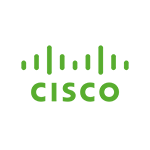- Cisco, Systèmes et Réseaux
- 0 (Registered)


Certification
CISCO IT
Obtenez une certification IT de carrière CISCO.
Référence
INF/SYS/SCOR
Durée
5 jours
Tarif (H.T.)
3950 €
Dates de session
Inscrivez-vous à la date de votre choix pour participer à l'une de nos sessions dans l'année.
15/01/2023 au 19/01/2024
08/04/2023 au 12/04/2024
01/07/2023 au 05/07/2024
18/11/2023 au 22/11/2024
Objectifs pédagogiques
- Describe information security concepts and strategies within the network
- Describe common TCP/IP, network application, and endpoint attacks
- Describe how various network security technologies work together to guard against attacks
- Implement access control on Cisco ASA appliance and Cisco Firepower Next-Generation Firewall
- Describe and implement basic email content security features and functions provided by Cisco Email Security Appliance
- Describe and implement web content security features and functions provided by Cisco Web Security Appliance
- Describe Cisco Umbrella® security capabilities, deployment models, policy management, and Investigate console
- Introduce VPNs and describe cryptography solutions and algorithms
- Describe Cisco secure site-to-site connectivity solutions and explain how to deploy Cisco Internetwork Operating System (Cisco IOS®) Virtual Tunnel Interface (VTI)-based point-to-point IPsec VPNs, and point-to-point IPsec VPN on the Cisco ASA and Cisco Firepower Next-Generation Firewall (NGFW)
- Describe and deploy Cisco secure remote access connectivity solutions and describe how to configure 802.1X and Extensible Authentication Protocol (EAP) authentication
- Provide basic understanding of endpoint security and describe Advanced Malware Protection (AMP) for Endpoints architecture and basic features
- Examine various defenses on Cisco devices that protect the control and management plane
- Configure and verify Cisco IOS software Layer 2 and Layer 3 data plane controls
- Describe Cisco Stealthwatch Enterprise and Stealthwatch Cloud solutions
- Describe basics of cloud computing and common cloud attacks and how to secure cloud environment
Profil participants
- Ingénieurs ou techniciens systèmes / réseaux, architectes réseau. Toute personne souhaitant se préparer à l’examen 350-701 Implementing and Operating Cisco Security Core Technologies (SCOR). La réussite de cet examen permet d’obtenir la certification Cisco Certified Specialist – Security Core.
Pré-requis
Etre familier avec les réseaux Ethernet et TCP-IP, Les concepts Cisco IOS, les concepts de sécurité réseau, connaitre le système d’exploitation Microsoft Windows, Avoir suivi la formation Mettre En Oeuvre Et Administrer Des Solutions Cisco [CCNA] ou posséder les connaissances équivalentes.
Programme de formation
Évaluation des acquis
1.
Describing Information Security Concepts*
- Information Security Overview
- Assets, Vulnerabilities, and Countermeasures
- Managing Risk
- Vulnerability Assessment
- Understanding Common Vulnerability Scoring System (CVSS)
2.
Describing Common TCP/IP Attacks*
- Legacy TCP/IP Vulnerabilities
- IP Vulnerabilities
- Internet Control Message Protocol (ICMP) Vulnerabilities
- TCP Vulnerabilities
- User Datagram Protocol (UDP) Vulnerabilities
- Attack Surface and Attack Vectors
- Reconnaissance Attacks
- Access Attacks
- Man-in-the-Middle Attacks
- Denial of Service and Distributed Denial of Service Attacks
- Reflection and Amplification Attacks
- Spoofing Attacks
- Dynamic Host Configuration Protocol (DHCP) Attacks
3.
Describing Common Network Application Attacks*
- Password Attacks
- Domain Name System (DNS)-Based Attacks
- DNS Tunneling
- Web-Based Attacks
- HTTP 302 Cushioning
- Command Injections
- SQL Injections
- Cross-Site Scripting and Request Forgery
- Email-Based Attacks
4.
Describing Common Endpoint Attacks*
- Buffer Overflow
- Malware
- Reconnaissance Attack
- Gaining Access and Control
- Gaining Access via Social Engineering
- Gaining Access via Web-Based Attacks
- Exploit Kits and Rootkits
- Privilege Escalation
- Post-Exploitation Phase
- Angler Exploit Kit
5.
Describing Network Security Technologies
- Defense-in-Depth Strategy
- Defending Across the Attack Continuum
- Network Segmentation and Virtualization Overview
- Stateful Firewall Overview
- Security Intelligence Overview
- Threat Information Standardization
- Network-Based Malware Protection Overview
- Intrusion Prevention System (IPS) Overview
- Next Generation Firewall Overview
- Email Content Security Overview
- Web Content Security Overview
- Threat Analytic Systems Overview
- DNS Security Overview
- Authentication, Authorization, and Accounting Overview
- Identity and Access Management Overview
- Virtual Private Network Technology Overview
- Network Security Device Form Factors Overview
6.
Deploying Cisco ASA Firewall
- Cisco ASA Deployment Types
- Cisco ASA Interface Security Levels
- Cisco ASA Objects and Object Groups
- Network Address Translation
- Cisco ASA Interface Access Control Lists (ACLs)
- Cisco ASA Global ACLs
- Cisco ASA Advanced Access Policies
- Cisco ASA High Availability Overview
7.
Deploying Cisco Firepower Next-Generation Firewall
- Cisco Firepower NGFW Deployments
- Cisco Firepower NGFW Packet Processing and Policies
- Cisco Firepower NGFW Objects
- Cisco Firepower NGFW Network Address Translation (NAT)
- Cisco Firepower NGFW Prefilter Policies
- Cisco Firepower NGFW Access Control Policies
- Cisco Firepower NGFW Security Intelligence
- Cisco Firepower NGFW Discovery Policies
- Cisco Firepower NGFW IPS Policies
- Cisco Firepower NGFW Malware and File Policies
8.
Deploying Email Content Security
- Cisco Email Content Security Overview
- Simple Mail Transfer Protocol (SMTP) Overview
- Email Pipeline Overview
- Public and Private Listeners
- Host Access Table Overview
- Recipient Access Table Overview
- Mail Policies Overview
- Protection Against Spam and Graymail
- Anti-virus and Anti-malware Protection
- Outbreak Filters
- Content Filters
- Data Loss Prevention
- Email Encryption
9.
Deploying Web Content Security
- Cisco Web Security Appliance (WSA) Overview
- Deployment Options
- Network Users Authentication
- Secure HTTP (HTTPS) Traffic Decryption
- Access Policies and Identification Profiles
- Acceptable Use Controls Settings
- Anti-Malware Protection
10.
Deploying Cisco Umbrella*
- Cisco Umbrella Architecture
- Deploying Cisco Umbrella
- Cisco Umbrella Roaming Client
- Managing Cisco Umbrella
- Cisco Umbrella Investigate Overview and Concepts
11.
Explaining VPN Technologies and Cryptography
- VPN Definition
- VPN Types
- Secure Communication and Cryptographic Services
- Keys in Cryptography
- Public Key Infrastructure
12.
Introducing Cisco Secure Site-to-Site VPN Solutions
- Site-to-Site VPN Topologies
- IPsec VPN Overview
- IPsec Static Crypto Maps
- IPsec Static Virtual Tunnel Interface
- Dynamic Multipoint VPN
- Cisco IOS FlexVPN
13.
Deploying Cisco IOS VTI-Based Point-to-Point IPsec VPNs
- Cisco IOS VTIs
- Static VTI Point-to-Point IPsec Internet Key Exchange (IKE) v2 VPN Configuration
14.
Deploying Point-to-Point IPsec VPNs on the Cisco ASA and Cisco Firepower NGFW
- Point-to-Point VPNs on the Cisco ASA and Cisco Firepower NGFW
- Cisco ASA Point-to-Point VPN Configuration
- Cisco Firepower NGFW Point-to-Point VPN Configuration
15.
Introducing Cisco Secure Remote Access VPN Solutions
- Remote Access VPN Components
- Remote Access VPN Technologies
- Secure Sockets Layer (SSL) Overview
16.
Deploying Remote Access SSL VPNs on the Cisco ASA and Cisco Firepower NGFW
- Remote Access Configuration Concepts
- Connection Profiles
- Group Policies
- Cisco ASA Remote Access VPN Configuration
- Cisco Firepower NGFW Remote Access VPN Configuration
17.
Explaining Cisco Secure Network Access Solutions
- Cisco Secure Network Access
- Cisco Secure Network Access Components
- AAA Role in Cisco Secure Network Access Solution
- Cisco Identity Services Engine
- Cisco TrustSec
18.
Describing 802.1X Authentication
- 802.1X and Extensible Authentication Protocol (EAP)
- EAP Methods
- Role of Remote Authentication Dial-in User Service (RADIUS) in 802.1X Communications
- RADIUS Change of Authorization
19.
Describing Endpoint Security Technologies*
- Host-Based Personal Firewall
- Host-Based Anti-Virus
- Host-Based Intrusion Prevention System
- Application Whitelists and Blacklists
- Host-Based Malware Protection
- Sandboxing Overview
- File Integrity Checking
- Cisco Identity Services Engine
- Cisco TrustSec
20.
Deploying Cisco Advanced Malware Protection (AMP) for Endpoints*
- Cisco AMP for Endpoints Architecture
- Cisco AMP for Endpoints Engines
- Retrospective Security with Cisco AMP
- Cisco AMP Device and File Trajectory
- Managing Cisco AMP for Endpoints
21.
Introducing Network Infrastructure Protection*
- Identifying Network Device Planes
- Control Plane Security Controls
- Management Plane Security Controls
- Network Telemetry
- Layer 2 Data Plane Security Controls
- Layer 3 Data Plane Security Controls
22.
Deploying Control Plane Security Controls*
- Infrastructure ACLs
- Control Plane Policing
- Control Plane Protection
- Routing Protocol Security
23.
Deploying Layer 2 Data Plane Security Controls*
- Overview of Layer 2 Data Plane Security Controls
- Virtual LAN (VLAN)-Based Attacks Mitigation
- Spanning Tree Protocol (STP) Attacks Mitigation
- Port Security
- Private VLANs
- Dynamic Host Configuration Protocol (DHCP) Snooping
- Address Resolution Protocol (ARP) Inspection
- Storm Control
- MACsec Encryption
24.
Deploying Layer 3 Data Plane Security Controls*
- Infrastructure Antispoofing ACLs
- Unicast Reverse Path Forwarding
- IP Source Guard
25.
Deploying Management Plane Security Controls*
- Cisco Secure Management Access
- Simple Network Management Protocol Version 3
- Secure Access to Cisco Devices
- AAA for Management Access
26.
Deploying Traffic Telemetry Methods*
- Network Time Protocol
- Device and Network Events Logging and Export
- Network Traffic Monitoring Using NetFlow
31.
Describing Software-Defined Networking (SDN*)
- Software-Defined Networking Concepts
- Network Programmability and Automation
- Cisco Platforms and APIs
- Basic Python Scripts for Automation
27.
Deploying Cisco Stealthwatch Enterprise*
- Cisco Stealthwatch Offerings Overview
- Cisco Stealthwatch Enterprise Required Components
- Flow Stitching and Deduplication
- Stealthwatch Enterprise Optional Components
- Stealthwatch Enterprise and ISE Integration
- Cisco Stealthwatch with Cognitive Analytics
- Cisco Encrypted Traffic Analytics
- Host Groups
- Security Events and Alarms
- Host, Role, and Default Policies
28.
Describing Cloud and Common Cloud Attacks*
- Evolution of Cloud Computing
- Cloud Service Models
- Security Responsibilities in Cloud
- Cloud Deployment Models
- Common Security Threats in Cloud
- Patch Management in the Cloud
- Security Assessment in the Cloud
29.
Securing the Cloud*
- Cisco Threat-Centric Approach to Network Security
- Cloud Physical Environment Security
- Application and Workload Security
- Cloud Management and API Security
- Network Function Virtualization (NFV) and Virtual Network Functions (VNF)
- Cisco NFV Examples
- Reporting and Threat Visibility in Cloud
- Cloud Access Security Broker
- Cisco CloudLock®
- OAuth and OAuth Attacks
30.
Deploying Cisco Stealthwatch Cloud*
- Cisco Stealthwatch Cloud for Public Cloud Monitoring
- Cisco Stealthwatch Cloud for Private Network Monitoring
- Cisco Stealthwatch Cloud Operations
* This section is self-study material that can be done at your own pace if you are taking the instructor-led version of this course.
Des questions ?
Moyens et méthodes pédagogiques
- Formateur pédagogue expert du domaine disposant d’une solide expérience terrain.
- 1 ordinateur par stagiaire, 1 support de cours par stagiaire (version papier ou numérique), 1 stylo et un bloc-notes par stagiaire
- Vidéoprojecteur et tableau blanc
- Feuille d’émargement à la demi-journée, questionnaire de satisfaction stagiaire, évaluations des acquis tout au long de la formation, attestation de stage
- Pédagogie active, s’appuyant sur la participation des apprenants.
- Pédagogie active, s’appuyant sur la participation des apprenants.
- Alternance d’apports théoriques (25 % environ) et d’exercices pratiques (75 % environ) basés sur les “meilleures pratiques” utilisées dans les situations professionnelles des apprenants.
- Les séquences pédagogiques peuvent comporter des présentations, des démonstrations, des échanges d’expériences, des exercices de complexité variable sous forme de travaux dirigés et de cas pratiques non guidés.
- L’animation est modulée en fonction des besoins et attentes des apprenants : difficultés rencontrées, évaluation intermédiaire des acquis, aide dans les travaux pratiques.


Evaluation des acquis
En amont de la formation
Questionnement et évaluation du besoin par téléphone par nos conseillers pédagogiques et formateurs
Au début de la formation
Tour de table pour prendre connaissance des attentes et niveau des stagiaires
En cours de formation
Evaluation continue des acquis des apprenants basée sur :
– la réalisation des travaux pratiques, dirigés ou non.
– les réponses aux questions orale
L’évaluation des acquis des apprenants peut être complétée par un questionnaire écrit type QCM (Questionnaire à Choix Multiples)
En fin de formation
– Validation des acquis par le formateur ou via un questionnaire renseigné par les stagiaires.
– Evaluation qualitative par les participants à l’issue de la formation via un questionnaire de satisfaction accessible en ligne.
– Une attestation de fin de formation reprenant les objectifs de formation est également remise aux stagiaires puis signée par le formateur.
Des questions ?
Un projet de formation ?
Course Content
Curriculum is empty
![Concevoir des réseaux sans fil d’entreprise Cisco [ENWLSD]](https://www.formation-forest.com/wp-content/uploads/2020/01/F2_1000X500_anastasia-dulgier-OKOOGO578eo-unsplash1000x500-277x310.jpg)